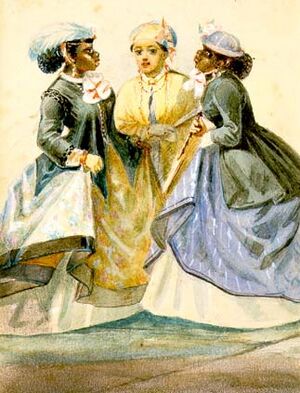Acadiana facts for kids
Quick facts for kids
Acadiana
L'Acadiane (Cajun French)
|
||
|---|---|---|
|
Region
|
||
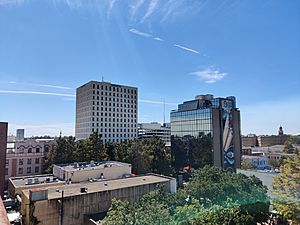
Downtown Lafayette, Louisiana
|
||
|
||
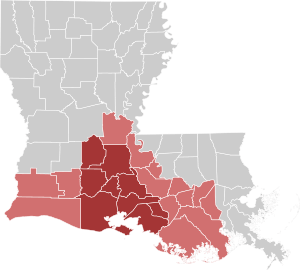
Map of Louisiana with Acadiana highlighted, and the heart of Acadiana in dark red
|
||
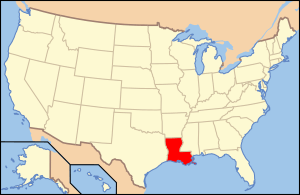
Location of Louisiana within the United States
|
||
| Country | United States | |
| State | Louisiana | |
| Legislative recognition | 1971 | |
| Largest city | Lafayette | |
| Population
(2020)
|
||
| • Total | 1,486,345 | |
| Demonym(s) |
|
|
Acadiana is a special region in Louisiana with a rich French history. It's also known as the Cajun Country. This area is officially recognized for having a large population of people who speak French and have strong French roots.
Many people living in Acadiana have ancestors who were Acadians. These are people who came from Canada a long time ago. They often identify as Cajuns or Creoles. Out of Louisiana's 64 parishes (which are like counties), 22 are officially part of Acadiana. Other nearby parishes also share a similar culture.
Contents
What Does "Acadiana" Mean?
The name "Acadiana" has two possible beginnings. It first appeared in a newspaper in Crowley, Louisiana, in 1946. The newspaper used it to talk about the part of Louisiana where French people, whose families were from Acadia, had settled.
Later, in the early 1960s, a TV station in Lafayette called KATC also started using the name. The station was owned by "Acadian Television Corporation." One day, they got a bill addressed to "Acadiana Television Corp." Someone had accidentally added an extra "a." The station liked the sound of it and started using "Acadiana" to describe the whole area their broadcasts reached.
Today, many businesses and groups use "Acadiana" in their names. Examples include the Mall of Acadiana and Acadiana High School. TV stations like KLFY-TV and KATC also use the name in their shows, like "Hello Acadiana" and "Good Morning Acadiana."
History of Acadiana
Long ago, this area was part of French Louisiana. Native American groups like the Atakapa lived here first. After the Seven Years' War, the British forced many French-speaking Acadians to leave Canada. Many of these refugees came to this part of Louisiana.
The Acadians married other settlers, and over time, their unique way of life became known as Cajun culture.
In 1971, the Louisiana State Legislature officially recognized 22 parishes for their "strong French Acadian cultural aspects." They called this area the "Heart of Acadiana." But most people still prefer to call it Acadiana. You can see this official name on maps and highway signs in the region.
Hurricanes in Acadiana
Like many parts of Louisiana, Acadiana can be hit by strong storms called hurricanes. These storms can cause a lot of damage.
For example, in 2002, Hurricane Lili hit the central part of Acadiana. Many homes lost power and phone service. Some buildings in Lafayette had broken windows and damaged roofs.
In 2005, Hurricane Katrina affected the eastern part of Acadiana. While the damage wasn't as bad as in New Orleans, many people who had to leave their homes found temporary shelter here. The city of Lafayette and other towns opened shelters, including the Cajundome, which housed thousands of people.
Later that year, Hurricane Rita hit the western part of Acadiana, causing a lot of damage, especially near Lake Charles.
In 2008, Hurricane Gustav caused widespread power outages and flooding across the region. However, fewer people died because many had evacuated safely. This was thanks to good plans from state and local officials.
More recently, in 2020, Hurricane Laura caused major damage to the western part of Acadiana. Just six weeks later, Hurricane Delta hit almost the same areas. These storms left many residents without power.
Geography of Acadiana
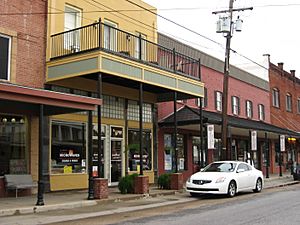
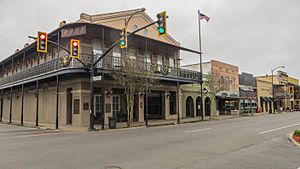
Acadiana has different types of land. In the north, there are gentle hills. In the south, closer to the Gulf Coast, you'll find dry prairies, marshes, and bayous. Wetlands are common near the Calcasieu River, Atchafalaya Basin, and the Mississippi River Delta. Farmers in this area grow crops like rice and sugarcane.
The Louisiana government says Acadiana stretches from just west of New Orleans to the Texas border along the Gulf Coast. It goes inland about 100 miles (160 km) to Marksville. This includes 22 parishes. The total land area of Acadiana is about 14,574 square miles (37,746 km²). To give you an idea, if Acadiana were a U.S. state, it would be bigger than Maryland!
Some parishes, like St. Charles, St. James, and St. John the Baptist, are called the River Parishes. This area was once known as the "German Coast" because German immigrants settled there in the 1700s. St. James and Ascension parishes were also called the "Acadian Coasts" because many Acadians settled there first.
Major Cities in Acadiana
The biggest cities in Acadiana are Lafayette, Lake Charles, and Houma-Thibodaux.
Other cities and towns in Acadiana include:
- Abbeville
- Breaux Bridge
- Crowley
- Eunice
- Franklin
- Gonzales
- Jennings
- Marksville
- Morgan City
- New Iberia
- Opelousas
- Rayne
- St. Martinville
- Sulphur
- Ville Platte
People of Acadiana
In 2020, about 1.48 million people lived in Acadiana.
Cajun and Creole Cultures
Cajuns are descendants of the Acadians who were forced to leave Canada in the 1700s. They are a very important part of Acadiana's culture. Not everyone in Acadiana is Cajun or speaks Louisiana French, but the Cajun culture is very visible here.
Acadiana is also home to Creoles. The term "Creole" can mean different things, but generally, it refers to people who are "native to Louisiana." Creoles have a mix of backgrounds, including French, Spanish, African, and Native American roots. Many Creoles are descendants of "free people of color" who played a big role in Louisiana's history. These free people of color were often successful business owners and professionals.
Over time, different groups in Louisiana mixed. French and Spanish colonists, Africans, and Native Americans all contributed to the diverse Creole culture. Today, many people celebrate their Creole heritage.
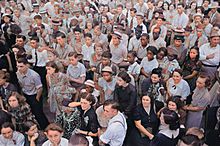
African Americans have also greatly shaped the region. Many of their ancestors were brought to Louisiana from Africa to work on plantations. They brought their own cultures, languages, and beliefs, which became part of Louisiana's unique traditions.
Other groups have also made Acadiana their home. These include Native American tribes like the Chitimacha and Houma. Anglo-Americans arrived after the Louisiana Purchase in 1803. More recently, families from Southeast Asia (like Laos, Vietnam, and Cambodia) have moved here, especially contributing to the fishing industry.
Religion in Acadiana
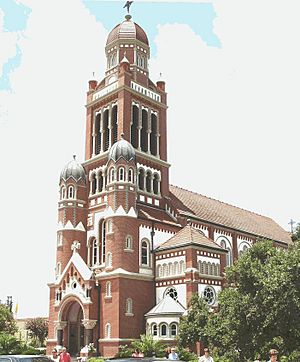
Unlike much of the southern United States, where most people are Protestant, Acadiana is mostly Roman Catholic. This is because of the strong French, Spanish, and Caribbean influences in the region's history. Most Catholics in Acadiana are part of the Roman Catholic Diocese of Lafayette in Louisiana.
Getting Around Acadiana
Transportation is very important in Acadiana for its industries like agriculture, petroleum, and tourism. It's also crucial for helping people evacuate during hurricanes. Because of the many swamps and marshes, it used to be hard to travel in Acadiana. This is why the early Cajun people were quite isolated.
After oil was discovered in the early 1900s, roads and waterways were improved for the oil industry. However, some of these changes have harmed the natural wetlands, which used to protect the area from storms.
Land Travel
Today, modern highways are key for getting around. Major roads like U.S. 90, U.S. 190, and U.S. 167 were important in the past. Now, Interstate 10, Interstate 210, Interstate 55, and Interstate 49 are the main routes.
Train travel is limited because of the many bridges needed over rivers and bayous. The main railways are the Burlington Northern Santa Fe Railroad and the Union Pacific Railroad.
Water Travel
Waterways are very important for business and fun activities in Acadiana. The region has many seaports, rivers, lakes, bayous, and canals. These were the main ways to ship goods and travel until the 1930s. The Mississippi River is important in the east, and the Atchafalaya River in the middle. The Calcasieu River helps shipping in the west, and the Sabine River forms the western border. The Intracoastal Waterway also helps people and goods move through the area.
Air Travel
Airports in Lafayette and Lake Charles offer regular flights. Helicopters are used to reach oil fields in the Gulf of Mexico. Smaller planes are used for short trips and for farming needs. Many communities also have small airports for general aviation.
Images for kids
See also
 In Spanish: Acadiana para niños
In Spanish: Acadiana para niños



